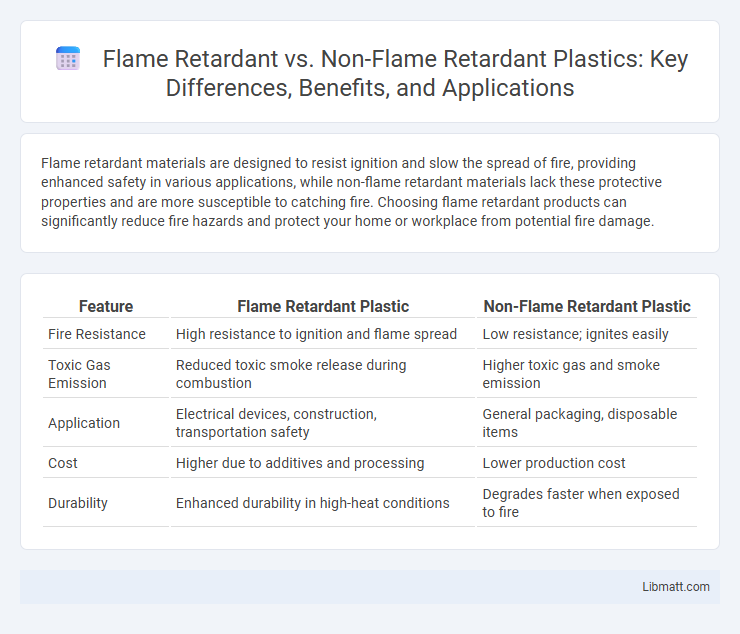Flame retardant materials are designed to resist ignition and slow the spread of fire, providing enhanced safety in various applications, while non-flame retardant materials lack these protective properties and are more susceptible to catching fire. Choosing flame retardant products can significantly reduce fire hazards and protect your home or workplace from potential fire damage.
Table of Comparison
| Feature | Flame Retardant Plastic | Non-Flame Retardant Plastic |
|---|---|---|
| Fire Resistance | High resistance to ignition and flame spread | Low resistance; ignites easily |
| Toxic Gas Emission | Reduced toxic smoke release during combustion | Higher toxic gas and smoke emission |
| Application | Electrical devices, construction, transportation safety | General packaging, disposable items |
| Cost | Higher due to additives and processing | Lower production cost |
| Durability | Enhanced durability in high-heat conditions | Degrades faster when exposed to fire |
Introduction to Flame Retardant and Non-Flame Retardant Materials
Flame retardant materials are engineered with chemicals that inhibit or resist the spread of fire, enhancing safety in various applications such as textiles, plastics, and electronics. Non-flame retardant materials lack these fire-resistant properties, making them more susceptible to ignition and faster combustion. The distinction between flame retardant and non-flame retardant is critical for regulatory compliance and risk management in industries requiring stringent fire safety standards.
Key Differences Between Flame Retardant and Non-Flame Retardant
Flame retardant materials contain chemical additives that significantly reduce the risk of ignition and slow down the spread of fire, making them essential for enhancing safety in textiles, electronics, and construction. Non-flame retardant materials lack these protective additives, resulting in higher flammability and increased fire hazard under exposure to heat or flame sources. The key differences lie in their chemical composition, fire resistance performance, and compliance with safety standards such as UL 94 or NFPA regulations.
How Flame Retardant Materials Work
Flame retardant materials work by interfering with the combustion process through chemical reactions that inhibit flame spread and reduce heat release. These materials often contain additives like halogens, phosphorus, or mineral compounds that promote char formation, dilute flammable gases, or cool the surface during a fire. Choosing flame retardant options enhances your safety by slowing fire progression and minimizing damage in hazardous environments.
Common Applications of Flame Retardant Products
Flame retardant products are widely used in industries requiring enhanced fire safety, including electronics, construction, and textiles. These materials are essential in manufacturing circuit boards, insulation panels, and furniture upholstery to prevent fire ignition and slow down flame spread. Unlike non-flame retardant products, flame retardant versions meet strict safety regulations and reduce overall fire hazards in residential, commercial, and industrial environments.
Benefits of Using Flame Retardant Materials
Flame retardant materials significantly enhance safety by reducing the risk of fire ignition and slowing combustion, giving occupants more time to evacuate and emergency responders a better chance to control the blaze. These materials also help in minimizing property damage and can lower insurance premiums due to their fire-resistant properties. Their use in construction, electronics, and textiles ensures compliance with stringent fire safety regulations, ultimately protecting lives and investments.
Potential Risks and Concerns of Flame Retardants
Flame retardants, commonly used in furniture, electronics, and textiles, pose potential health risks due to their chemical composition, which can release toxic substances such as polybrominated diphenyl ethers (PBDEs) into indoor environments. Exposure to these chemicals has been linked to endocrine disruption, neurodevelopmental deficits, and increased cancer risk in humans, raising significant public health concerns. Unlike non-flame retardant materials, which lack these additives, flame retardants contribute to environmental persistence and bioaccumulation, amplifying ecological harm and human exposure over time.
Environmental Impact: Flame Retardant vs Non-Flame Retardant
Flame retardant materials often contain chemical additives that can persist in the environment, potentially leading to soil and water contamination and affecting wildlife health. Non-flame retardant alternatives typically have a lower environmental footprint by avoiding these chemicals, reducing the risk of harmful bioaccumulation and pollution. Evaluating your product's sustainability requires balancing fire safety benefits with the long-term ecological impact of flame retardant chemicals.
Regulatory Standards and Certifications
Flame retardant materials comply with stringent regulatory standards such as UL 94, NFPA 701, and RoHS to ensure they reduce fire hazards and meet safety certifications. Non-flame retardant products often lack certifications from agencies like ASTM or EN ISO 11925, limiting their use in fire-sensitive environments. Your choice between flame retardant and non-flame retardant should consider compliance with local and international fire safety regulations to ensure optimal protection and legal adherence.
Cost Comparison and Economic Considerations
Flame retardant materials typically incur higher costs due to specialized chemical treatments and rigorous testing requirements compared to non-flame retardant alternatives. Your selection impacts long-term economic considerations, as flame retardant products may reduce fire-related damages and insurance premiums, offering potential savings despite the upfront investment. Evaluating both immediate costs and risk mitigation benefits is crucial for an informed decision.
Choosing the Right Material: Factors to Consider
Selecting the right material between flame retardant and non-flame retardant depends on fire safety regulations, application environment, and performance requirements. Flame retardant materials provide enhanced protection by resisting ignition and slowing fire spread, crucial in construction, electronics, and automotive industries. Non-flame retardant materials may be suitable for applications with low fire risk or where chemical treatment is undesirable, balancing cost-effectiveness with safety considerations.
Flame Retardant vs Non-Flame Retardant Infographic

 libmatt.com
libmatt.com